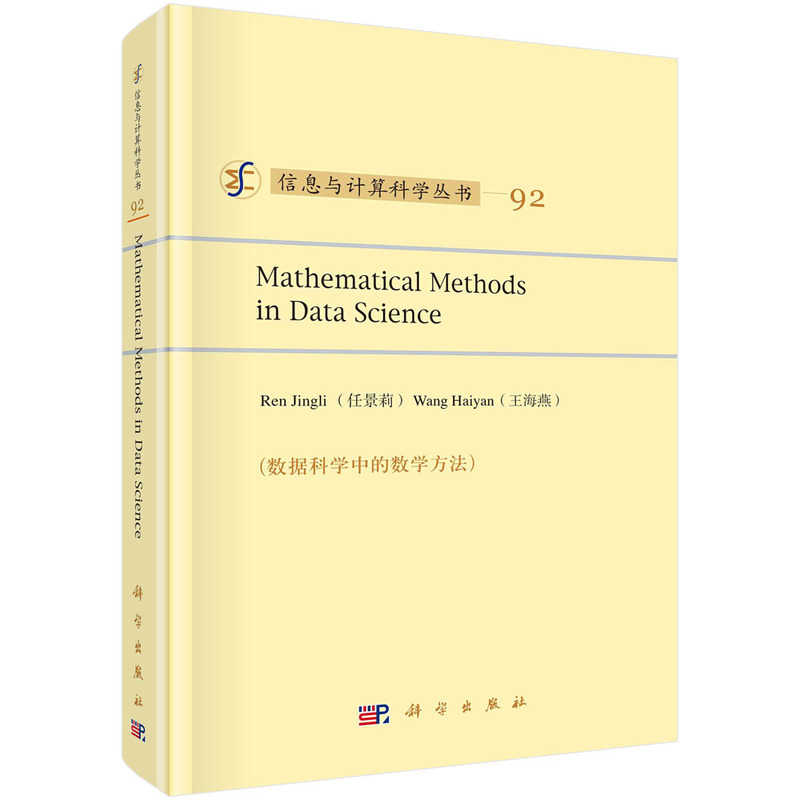暂无评论
图文详情
- ISBN:9787030747563
- 装帧:圆脊精装
- 册数:暂无
- 重量:暂无
- 开本:B5
- 页数:264
- 出版时间:2023-02-01
- 条形码:9787030747563 ; 978-7-03-074756-3
内容简介
该书系统介绍了数理医学概念、问题、方法及应用,是这个新领域的导引性著作。数理医学是一门数学、数据科学、信息科学与医学相交叉的学科,既着眼于解决智慧医疗中的棘手问题达到造福患者的目的,又着重提炼和研究数理医学中的基本数学问题和方法。该书既讨论成熟的原理和方法,又讨论一些前瞻性的问题和想法。期望读者能够通过本书的引导,进一步研究和丰富数理医学的基本原理和方法,共同推动这一新方向的发展和应用。
目录
Contents
Preface ix
Acknowledgments xi
1. Linear algebra 1
1.1. Introduction 1
1.2. Elements of linear algebra 2
1.2.1. Linear spaces 2
1.2.2. Orthogonality 5
1.2.3. Gram-Schmidt process 10
1.2.4. Eigenvalues and eigenvectors 11
1.3. Linear regression 17
1.3.1. QR decomposition 17
1.3.2. Least-squares problems 18
1.3.3. Linear regression 20
1.4. Principal component analysis 21
1.4.1. Singular value decomposition 21
1.4.2. Low-rank matrix approximations 24
1.4.3. Principal component analysis 25
2. Probability 31
2.1. Introduction 31
2.2. Probability distribution 32
2.2.1. Probability axioms 32
2.2.2. Conditional probability 33
2.2.3. Discrete random variables 34
2.2.4. Continues random variables 38
2.3. Independent variables and random samples 41
2.3.1. Joint probability distributions 41
2.3.2. Correlation and dependence 44
2.3.3. Random samples 47
2.4. Maximum likelihood estimation 48
2.4.1. MLE for random samples 48
2.4.2. Linear regression 49
3. Calculus and optimization 51
3.1. Introduction 51
3.2. Continuity and differentiation 52
3.2.1. Limits and continuity 52
3.2.2. Derivatives 54
3.2.3. Taylor's theorem 62
3.3. Unconstrained optimization 65
3.3.1. Necessary and sufficient conditions of local minimizers 65
33.2. Convexity and global minimizers 69
3.3.3. Gradient descent 74
3.4. Logistic regression 76
3.5. K-means 79
3.6. Support vector machine 80
3.7. Neural networks 83
3.7.1. Mathematical formulation 83
3.7.2. Activation functions 85
3.7.3. Cost function 87
3.7.4. Backpropagation 87
3.7.5. Backpropagation algorithm 88
4. Network analysis 91
4.1. Introduction 91
4.2. Graph modeling 92
4.3. Spectral graph bipartitioning 99
4.4. Network embedding 105
4.5. Network based influenza prediction 106
4.5.1. I ntrod uction 107
4.5.2. Data analysis with spatial networks 111
4.5.3. ANN method for prediction 118
5. Ordinary differential equations 129
5.1. Introduction 129
5.2. Basic differential equation models 130
5.2.1. Logistic differential equations 130
5.2.2. Epidemical model 131
5.3. Prediction of daily PM2.5 concentration 134
5.3.1. Introduction 134
5.3.2. Genetic programming for ODE 136
5.3.3. Experimental results and prediction analysis 143
5.4. Analysis of COVID-19 148
5.4.1. Introduction 148
5.4.2. Modeling and parameter estimation 152
5.4.3. Model simulations 160
5.4.4. Conclusion and perspective 165
5.5. Analysis of COVID-19 in Arizona 166
5.5.1. Introduction 166
5.5.2. Data sources and collection 167
5.5.3. Model simulations 168
5.5.4. Remarks 170
6. Partial differential equations 173
6.1. Introduction 173
6.2. Formulation of partial differential equation models 174
6.3. Bitcoin price prediction 179
6.3.1. Network analysis for bitcoin 181
6.3.2. PDE modeling 184
6.3.3. Bitcoin price prediction 186
6.3.4. Remarks 190
6.4. Prediction of PM2.5 in China 192
6.4.1. Introduction 192
6.4.2. PDE model for PM2.5 194
6.4.3. Data collection and clustering 195
6.4.4. PM2.5 prediction 197
6.4.5. Remarks 199
6.5. Prediction of COVID-19 in Arizona 202
6.5.1. Introduction 202
6.5.2. Arizona COVID data 204
6.5.3. PDE modeling of Arizona COVID-19 206
6.5.4. Model prediction 209
6.5.5. Remarks 210
6.6. Compliance with COVID-19 mitigation policies in the US 213
6.6.1. I ntrod uction 213
6.6.2. Data set sources and collection 216
6.6.3. PDE model for quantifying compliance with COVID-19 policies 217
6.6.4. Model prediction 221
6.6.5. Analysis of compliance with the US COVID-19 mitigation policy 224
6.6.6. Remarks 226
Bibliography 229
Index 241
展开全部
本类五星书
本类畅销
-

勒维特之星-大发现系列丛书
¥4.0¥16.0 -

喜马拉雅山珍稀鸟类图鉴
¥27.2¥68.0 -

昆虫的生存之道
¥12.2¥38.0 -

昆虫采集制作及主要目科简易识别手册
¥15.0¥50.0 -

古文诗词中的地球与环境事件
¥8.7¥28.0 -

声音简史
¥21.3¥52.0 -

不匹配的一对:动物王国的性别文化
¥16.7¥42.8 -

物理学之美-插图珍藏版
¥20.7¥69.0 -

现代物理学的概念和理论
¥18.4¥68.0 -

技术史入门
¥14.4¥48.0 -

几何原本
¥35.6¥93.6 -

改变世界的发现
¥15.4¥48.0 -

图说相对论(32开平装)
¥13.8¥46.0 -

数学的魅力;初等数学概念演绎
¥7.7¥22.0 -

星空探奇
¥14.0¥39.0 -

宇宙与人
¥10.5¥35.0 -

数学专题讲座
¥13.3¥29.0 -

袁隆平口述自传
¥19.9¥51.0 -

为了人人晓得相对论
¥3.9¥13.5 -

一代神话:哥本哈根学派
¥8.1¥15.5













